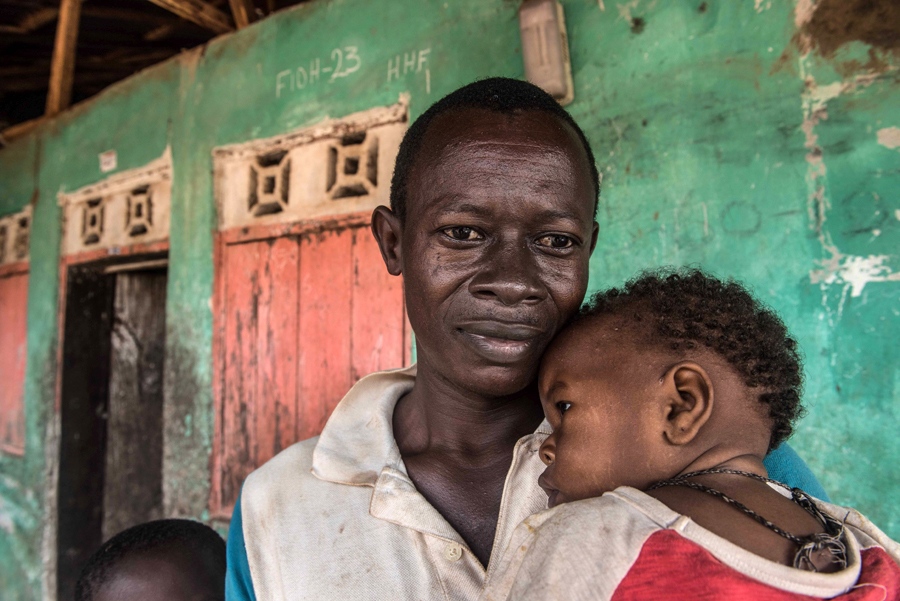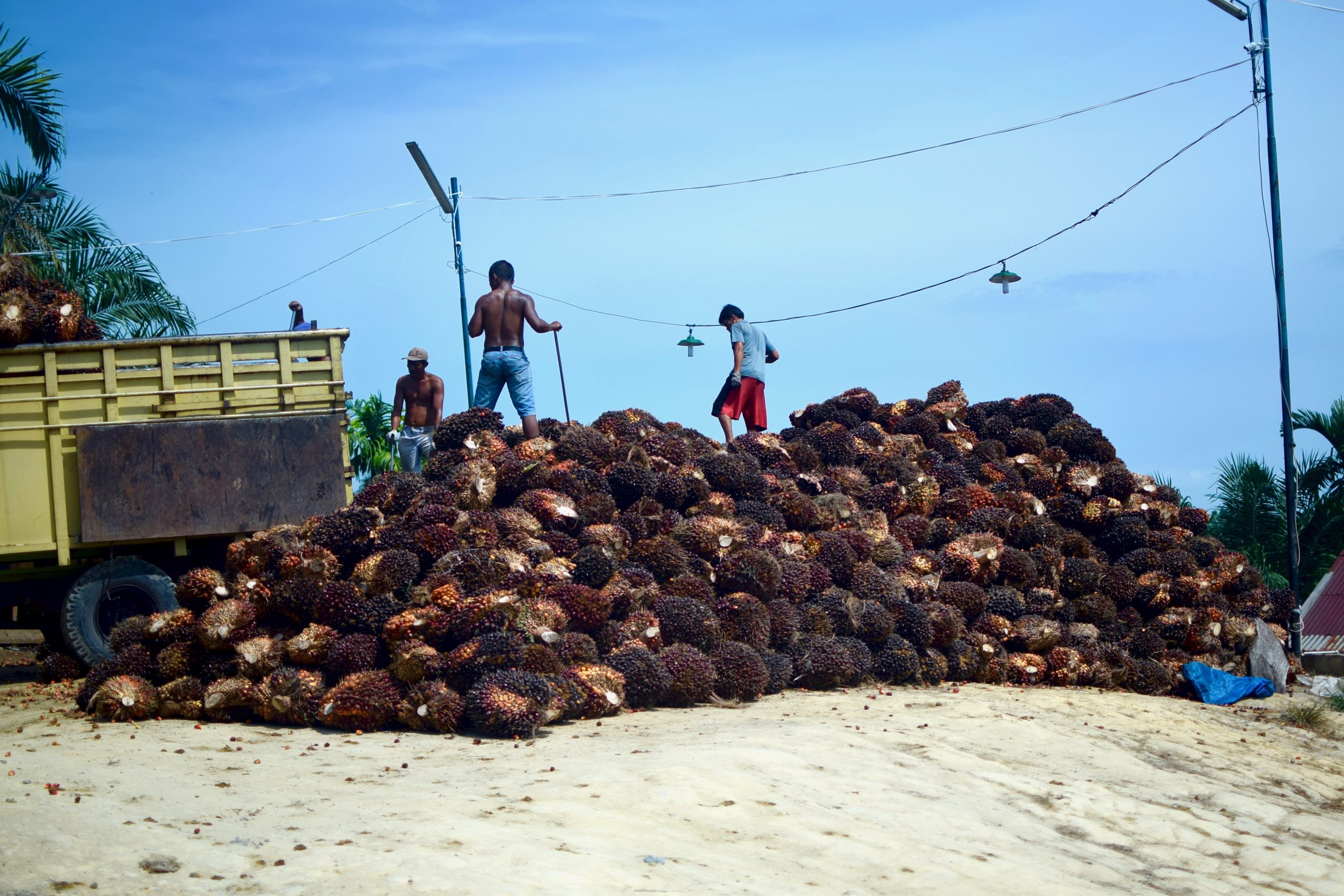
In November 2014, Erika Check Hayden left her San Francisco home for Sierra Leone, to report for Nature (where she was then a staff reporter) on how Africans and aid organizations were responding to the Ebola outbreak. Emotionally, that reporting would turn out to be unlike any other story she had done. Even when she was back home in San Francisco, Check Hayden found the news “so devastating,” she says. “There was a period of time—pretty much every working day—where I would get up, do an interview, read a story, watch a video, or look at a photo essay, and just cry.” And although covering the story close-up was mentally and emotionally draining, Check Hayden knew it was important for her to do so.
At an Ebola treatment center in Bo, Sierra Leone’s second largest city, Check Hayden met a family—a mother, father, and their children—who were all infected with Ebola. The day Check Hayden was there, the family had just learned their youngest child died. The father seemed to be doing well with the disease, but it wasn’t clear whether or not the mother was going to survive—and her child’s death was sapping her own will to live.
Check Hayden couldn’t help but feel emotionally affected—nor, she says, would denying her response benefit her work. “Being able to admit to yourself and to access the fact that you are really affected by something motivates you to do your job as a journalist and follow the story,” she says. The family’s heartbreaking circumstances spurred her to follow their story even after she left Bo. (The family’s story ended more happily than some: the mother, father, and remaining two children survived.)
The mental health hazards of covering war, terrorism, violence, and other disasters are well known. But science, environmental, and health journalists can also be at risk. Science journalists might experience what clinical psychologists call “vicarious trauma,” which refers to the emotions that arise when reporters bear witness to another person’s suffering. Covering topics such as chronic or rare illnesses, infectious disease outbreaks, climate change, extinctions, and other environmental crises can evoke anxiety, fear, and guilt, or even trigger post-traumatic stress. “If you’re connecting with another suffering human being and you’re doing your work well, you can’t help but to be moved in ways that are both positive and negative,” says Elana Newman, a clinical psychologist and research director for the DART Center on Journalism and Trauma. “Bearing witness is an occupational hazard that most journalists aren’t trained for.”
Science journalists—like war reporters—need to take such mental health impacts of their work seriously, says Check Hayden, who is now director of the Science Communication Program at the University of California, Santa Cruz. “We are increasingly called upon to cover crises and traumatic events because we have a particular expertise to bring,” she says. “As a profession, we need to develop standards and ethical practices around doing crisis reporting. This would include ways to protect the health and safety of reporters, including their mental health.”
Lean on Your Support Network
Being alone tends to make any trauma worse. That’s why Newman, who researches the impact that reporting on traumatic events can have on reporters’ mental health, says the most important factor in mental health and resilience in the face of trauma is social support. She urges journalists on assignment—especially in emotionally difficult terrain—to find ways to avoid being isolated.
That advice resonates with journalist Dan Fagin, who is director of New York University’s Science, Health, and Environmental Reporting Program and author of the Pulitzer Prize–winning book Toms River, which documents a 60-year saga of industrial pollution in a small New Jersey town and the role that pollution played in a cluster of childhood cancers. While reporting the book, he spent long periods of time with families that had experienced trauma “orders of magnitude higher than my own,” he recalls. When the emotional stress of bearing witness to that trauma became intense, Fagin says, “I’d talk about reporting problems I’m running into or writing blocks with my wife,” who is also a journalist. “I’d also talk to my friends or kids—I’d talk less about the journalism and [more about] how I was reacting as a human. It was helpful for me to process what I was experiencing.”
But many reporting assignments pull journalists away from their friends, partners, and peers back home. One way to mitigate isolation while reporting from the field is to collaborate with colleagues, such as other reporters, visual journalists, fixers, or translators.
When journalist Apoorva Mandavilli (who is editor-in-chief of the autism-focused publication Spectrum and also freelances on other subjects) went to Bhopal, India, to report on the lingering public health effects of the 1984 gas leak there that killed thousands and injured many more, she brought a photographer friend, Raj Sarma, with her. “That was the best mental health decision I could have made,” she says. She and Sarma witnessed people living in extreme poverty and met people who were desperately ill and who had little access to medical help. One morning, they visited a center that cares for children who became disabled as a result of the gas leak. Such experiences were painful to observe, Mandavilli says, but having a colleague with her helped. “In the evenings, we’d go for a drink and process what we saw during the day or talk about something else entirely.”

Check Hayden, too, worked with a local photographer when she first arrived in Sierra Leone. “It was so incredibly helpful,” she says. “When you’re in the field, you can’t really get guidance from your editor, so it’s helpful to work with someone else who is knowledgeable and professional.”
When you can get in touch with them, though, editors can be an important source of support. Not only can an editor’s fresh pair of eyes provide focus and clarity to a story, or tone down emotions or details that might not serve readers, they can also be an important piece of the social network that reporters need.
“Editors don’t need to be therapists,” says Newman. “But they can employ the same reporting skills as they would to a story, to just ask a reporter, ‘Hey, that was a tough story. What was it like being in the field?’ We’re not advocating for editors to do anything therapeutic, other than having an informed conversation.” (The DART Center offers several resources that editors can employ in their newsrooms.)
Pace Your Reporting and Take Breaks
While on assignment, reporters can feel pressured to report as much as possible in the time available. But taking breaks from reporting can benefit a journalist’s mental health.
When reporting emotionally stressful stories, Mandavilli deliberately builds in time “cushions” at the end of the day. When she went to London to meet the protagonist of her Spectrum story “The Lost Girls,” which investigated the experiences of girls and women with autism, she planned time to see friends and family after she finished her reporting. “This strategy is contrary to advice people give you, which is to go put all your thoughts and impressions at the end of the day down on paper,” Mandavilli notes. “I could only do that for an hour before I had to leave my hotel room and talk about something completely different.”
Last year, I spent three months investigating (for Nature, PRI’s The World, and STAT) whether palm oil from Southeast Asia can be produced in an environmentally and socially sustainable manner. After just a week of reporting from the heart of Indonesia’s palm oil–producing province, I noticed the mental toll that the work had on me. Constantly looking at land that had been plundered for the needs of the world and listening to the stories of workers who were exploited, I felt uncharacteristically sapped of energy and had a hard time focusing on my work.
Altogether, I reported in three countries, for about three weeks each. After I completed my work in one country, I took a week off to meet up with friends in different parts of Thailand to disconnect from my reporting, before jumping back in. These self-imposed breaks—in settings that were so distinct from the hazy cities and palm oil plantations I was reporting in—helped me recharge so that when it was time to report again, I was excited to do so.

Look for Positive Stories
Environmental journalist John Platt is no stranger to the emotional cost of covering a beat that often lends itself to dismal stories. Now editor-in-chief of The Revelator, which does investigative reporting on the environment, wildlife, and other related topics, Platt has written about extinction for more than a decade. “The collective impact of reporting on extinction,” he says, “is the death of a thousand paper cuts.”
To slow the bleeding, Platt mixes his reporting on extinction with freelance reporting on the technology beat. He has recently written about teenagers who are designing self-cooling solar cells and about devices that can detect the onset of Parkinson’s disease. “Being able to write about something completely different that is inherently positive has been helpful,” he says. He also urges reporters to seek out a fun or hopeful story on the environmental beat from time to time. “If you can tell a positive story that shows your readers that not everything is terrible, you remind yourself of the same thing.”
When I was working on my palm oil stories last year, I tried to not spend long, unbroken spells of time reporting on depressing plantation conditions—the kind of work I thought was exerting the greatest toll on my mental health. I alternated weeks of interviewing people who were suffering from their work on plantations with weeks in which I would speak to NGO leaders, government officials, policy makers, or scientists—people who were thinking about solutions in the palm oil industry and had a more optimistic mindset.
Do Emotions Have a Place in the Story?
When it comes time to sit down and write a story—particularly one that was mentally and emotionally intense to report—strong waves of emotions might resurface and leak into a reporter’s writing.
In a feature story for Nature about how the Ebola outbreak in Sierra Leone affected the ability of a hospital to continue its research, Check Hayden took a solemn tone. Her choice of language in the story, she says, reflected the emotions that her sources—and she herself—felt in the wake of the deaths of many of their colleagues.
Mandavilli says she tries not to censor herself when she writes her first draft. When she was writing “The Lost Girls” for Spectrum, Mandavilli says, her editor, Kat McGowan, highlighted certain details and asked why they mattered for the story. “I think a really good editor can connect certain facts back to the main point of the article, rather than having the reader potentially going down a really sad journey,” Mandavilli says.
Some reporters worry that allowing their own emotional experience to seep into their stories reflects a failure of journalistic objectivity. But journalists’ emotional responses to the situations they observe are a legitimate part of the factual record. Fagin says communicating your own reactions can be a service to your audience. After all, the most emotionally resonant stories are often the ones that will stick with readers.
However, Fagin cautions that you should “make distinctions between your analysis of facts and evidence—which should be dispassionate—and your descriptions of characters, which can be passionate.”
When Platt started writing about endangered species, he tried to infuse some humor into his writing—to bring levity to an otherwise serious topic by making fun of the people or situations that were causing extinctions. But as time has gone on, his writing about extinction has gotten more and more “deadly serious,” Platt says. “I think that’s the best way to address it—to be flat-out serious, respectful, and approach the topic with the right amount of anger and righteous journalistic fury while being fair, honest, and truthful in your reporting.”

Wudan Yan is an independent investigative journalist based in Seattle, Washington. Her writing has appeared in Discover, Hakai Magazine, Nature, Nature Medicine, The New Yorker, NPR, Public Radio International, STAT, and The Washington Post, among others. Her reporting has been supported by the Pulitzer Center on Crisis Reporting and UC Berkeley’s 11th-Hour Food and Farming Fellowship. Follow her on Twitter @wudanyan.


